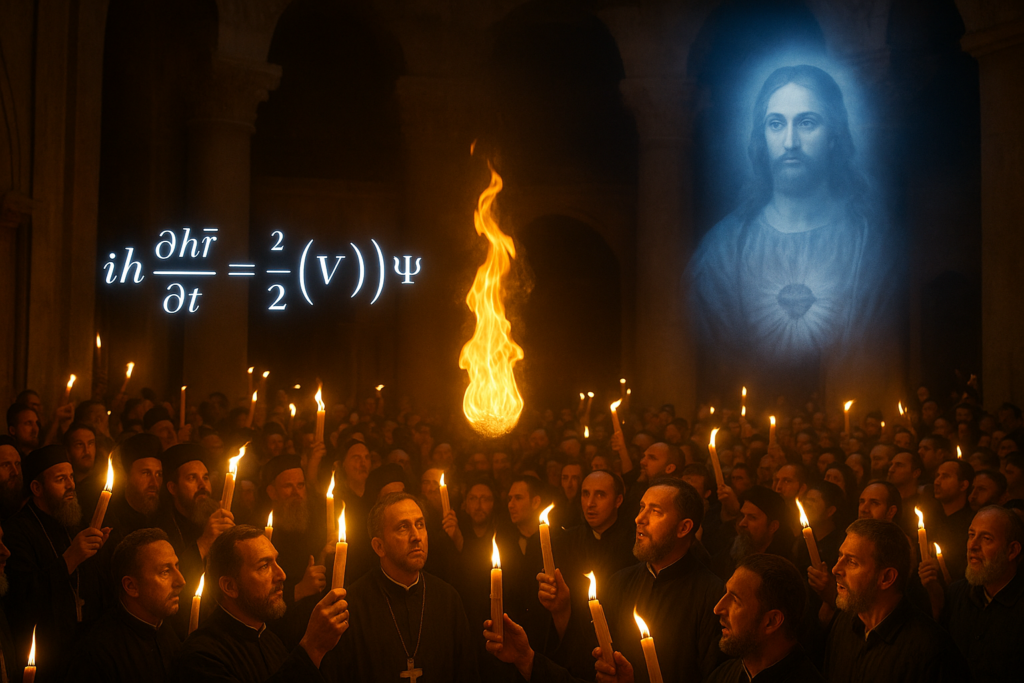✨ A mystery that challenges science and inspires faith
Each year, on Orthodox Easter in Jerusalem, something strange, mysterious, and sacred takes place. In the Church of the Holy Sepulchre, before the eyes of thousands of believers and under strict surveillance by religious authorities and representatives of other faiths, a flame spontaneously appears—without any apparent ignition. This event is known as the Holy Fire, and according to the accounts of those present, it is not just a symbolic ritual, but a physical and visible event.
What makes the phenomenon even more unusual is that in the first moments after its appearance, the flame does not burn. Many participants in the ceremony wave the flame across their faces, hands, and hair without experiencing burns. This peculiarity is one of the reasons the flame is called holy or grace-filled.
There have been numerous attempts to prove that the Holy Fire is the result of a well-prepared deception. However, despite modern surveillance equipment and the presence of neutral observers, no one has managed to demonstrate fraud or manipulation. On the other hand, science has not yet explained the physical mechanism by which the flame appears or why it initially lacks thermal effects.
🔥 Between Faith and Quantum Speculation
If we want to analyze this event from a broader perspective, we must first accept that the Holy Fire exists as an empirical phenomenon. The next step is to explore how such an event could theoretically be possible. One of the closest analogies in known science is the phenomenon of firewalking, in which individuals walk barefoot across hot embers without sustaining burns. This is usually attributed to a combination of thermal conductivity, short contact time, and the mental and emotional state of the participants—often referred to as a kind of trance.
Could it be that in the case of the Holy Fire, something similar occurs? Could the emotional unity, strong faith, and spiritual energy of thousands of people gathered in one place influence the physical properties of the environment?
🧠 A Glimpse into the Quantum Mind
This leads us to the more speculative, yet extremely intriguing domain of quantum mechanics. Quantum physics teaches us that the very act of observation can change reality, that particles can be entangled at a distance, and that systems exist in superposition until observed. Some physicists and philosophers propose that consciousness itself may be part of the quantum field and influence the behavior of matter.
Could the appearance of the Holy Fire be a manifestation of collective consciousness in a state of resonance? Could a critical mass of believers, synchronized in prayer and expectation, create conditions for the emergence of a macroscopic quantum phenomenon—a temporary anomaly in the behavior of matter?
✝️ Science, Mystery, and Meaning
Of course, such claims are not scientifically proven, and we are moving into a field where mysticism and science touch, but do not yet blend. Nevertheless, events like the Holy Fire challenge the boundaries of our understanding and remind us that not all phenomena fit neatly into the categories of known physics.
For those who believe, the Holy Fire is a sign of divine presence. For skeptics, it is a mystery yet to be solved. But for scientists open to new paradigms, it may be an invitation to broaden the framework in which we interpret reality.
👉 MilovanInnovation will continue to explore such phenomena at the intersection of science, consciousness, and the unknown—where curiosity meets wonder.


Leave a Reply